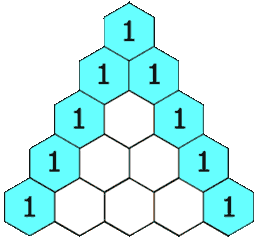118. Pascal's Triangle
Given a non-negative integer numRows, generate the first numRows of Pascal's triangle.
 In Pascal's triangle, each number is the sum of the two numbers directly above it.
In Pascal's triangle, each number is the sum of the two numbers directly above it.
Example:
Input: 5
Output:
[
[1],
[1,1],
[1,2,1],
[1,3,3,1],
[1,4,6,4,1]
]
思路
该题比较简单,杨辉三角形,从第三行开始,除了首尾,中间元素的值可通过如下公式计算:cur[i] = prev[i] + prev[i-1]
计算当前行实现要点如下:
- 拷贝上一行,并在末尾添加元素1
- 倒着开始计算,i 不包括首尾,
cur[i] += cur[i-1]
C++11
class Solution {
public:
vector<vector<int>> generate(int numRows) {
vector<vector<int>> res;
for (auto i = 0; i < numRows; ++i) {
vector<int> row;
if (!res.empty())
row.assign(res.at(i-1).begin(), res.at(i-1).end());
row.emplace_back(1);
for (auto j = i - 1; j > 0; --j)
row[j] += row[j-1];
res.emplace_back(row);
}
return res;
}
};
update 2019.03.07
class Solution {
public:
vector<vector<int>> generate(int numRows) {
vector<vector<int>> res;
if (!numRows) return res;
res = {{1}};
for (int i = 1; i < numRows; i++) {
vector<int> row;
row.assign(res.at(i-1).begin(), res.at(i-1).end());
row.emplace_back(1);
for (int j = row.size() - 2; j > 0; j--) {
row[j] += row[j-1];
}
res.emplace_back(row);
}
return res;
}
};
ac结果:
Runtime: 4 ms, faster than 100.00% of C++ online submissions for Pascal's Triangle.
Memory Usage: 8.9 MB, less than 24.64% of C++ online submissions for Pascal's Triangle.
内存使用有点高,后面再来想办法改进一下。